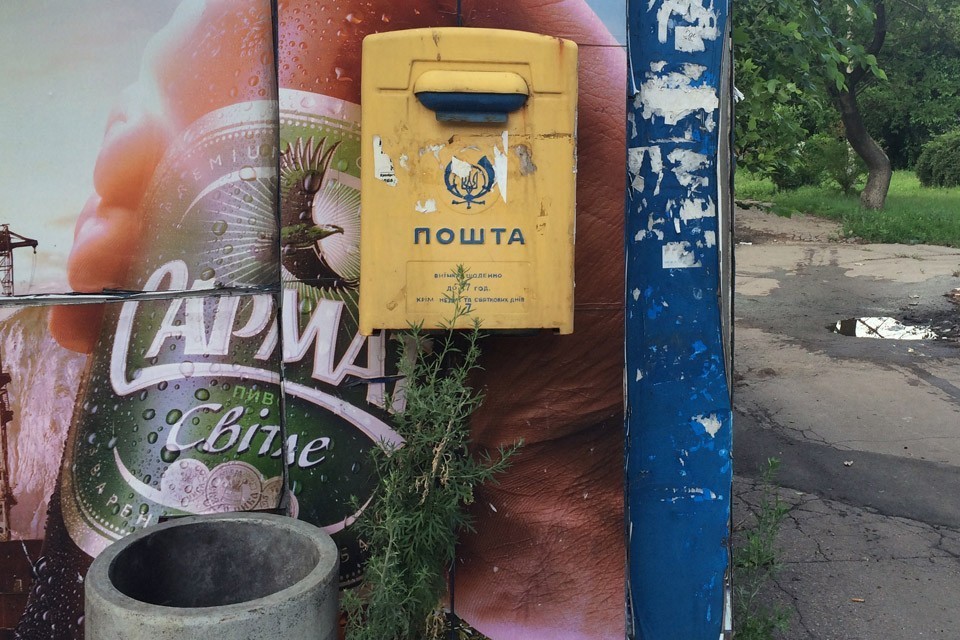
Welcome to Donetsk: Anastasia Taylor-Lind and Her Postcards from the War in the East

I was in Slavyansk in summer 2014 when I set off to the post office to find out what kind of postcards they sold. I found two that stuck out in my memory. When I went back to England I decided to find the company that printed them. It turned out that it had been closed since the beginning of the war and the owner had left Ukraine. I located his mother-in-law and she had a package with the postcards in her basement. I came to Donetsk in July 2015 and bought them. There were 929 postcards in the package.
{“img”: “/wp-content/uploads/2015/08/anastasiataylorlind_03.jpg”, “text”: “”}
When I first looked at the postcards I thought, “Wow, Donetsk looks like a typical city in these pictures.” When I see documentary photos from the east in which people are shooting at each other with Kalashnikovs against a backdrop of destroyed buildings, I understand that this is the reality. But those buildings that we see in the postcards are still intact.
I made a post on Instagram and offered people to leave their postal addresses so they could receive a postcard. I hired Alisa Sopova, a wonderful journalist from Donetsk, and together we searched for the victims’ names, place of death and the circumstances surrounding their death in order to write about it on the flip side of the cards. The official sources from which we could get information on the victims are not even in Ukraine. We generally took them from memorial websites, taking information about the dead from both sides of the conflict, journalists, citizens, disaster victims and even Russian soldiers. It took me 10 days to write out all of the postcards.
{“img”: “/wp-content/uploads/2015/08/anastasiataylorlind_01.jpg”, “text”: “”}
The front-side image of the card is an idealistic view of the city, and on the other side, you will read the reality that exists. I don’t think it’s worth it to take new pictures of the same places there and show them off. The effect is stronger when you show less but with more meaning. What’s interesting is the distance between the cities marked in the addresses: we write about a person dying in Slavyansk, Volnovakha or Lugansk but the postcard is headed to, for example, quiet, little Pleasantville, USA.
{“img”: “/wp-content/uploads/2015/08/anastasiataylorlind_04.jpg”, “text”: “Shiing Ng was killed over Grabovo on Thursday the 17th of July, 2014.”},
{“img”: “/wp-content/uploads/2015/08/anastasiataylorlind_05.jpg”, “text”: “Sergiy Bovsunovsky was killed in Schastye on Wednesday the 2nd of July, 2014.”},
{“img”: “/wp-content/uploads/2015/08/anastasiataylorlind_06.jpg”, “text”: “Anastasia Podlibskaya was killed in Gorlovka on Thursday the 7th of August, 2014. She was 11 months old.”},
{“img”: “/wp-content/uploads/2015/08/anastasiataylorlind_07.jpg”, “text”: “Illya Valyavsky was killed in Schastye on Tuesday the 17th of June, 2014.”},
{“img”: “/wp-content/uploads/2015/08/anastasiataylorlind_08.jpg”, “text”: “Ruslan Konoshenko was killed at Donetsk Airport on Wednesday the 21st of January, 2015.”},
{“img”: “/wp-content/uploads/2015/08/anastasiataylorlind_09.jpg”, “text”: “Lilya Nimenko was killed in Mariupol on Saturday the 24th of January, 2015.”}
This is a project on a war that affects everyone. You don’t see it when you’re sitting in a cafe but you feel it all around you. War jumps into every conversation, or maybe you see a soldier in a uniform at a metro station. How can I, as a narrator, show the discrepancy between a routine and everyday life and violence in the same country? This is why I decided to experiment with a different form of media: I’m going to do a video installation about how the war affects everyday life and finish the project with these cards.
The majority of postcards were sent to Europe and America, and others were sent to China, New Zealand, Namibia, The Philippines, Georgia and other countries. Ukrainians and Russians also left me their addresses. I don’t know who the receivers are and I doubt that they read The New York Times or The Times. They probably don’t want to know much more about Ukraine, but they did want to participate. I was able to reach people that I couldn’t reach through traditional media. I can’t say exactly how many people will find out about the project, but the most important thing, really, is involvement, touching another person and pushing him to reflect on the conflict.
{“img”: “/wp-content/uploads/2015/08/anastasiataylorlind_21.jpg”, “text”: “”},
{“img”: “/wp-content/uploads/2015/08/anastasiataylorlind_22.jpg”, “text”: “”},
{“img”: “/wp-content/uploads/2015/08/anastasiataylorlind_23.jpg”, “text”: “”},
{“img”: “/wp-content/uploads/2015/08/anastasiataylorlind_24.jpg”, “text”: “”},
{“img”: “/wp-content/uploads/2015/08/anastasiataylorlind_25.jpg”, “text”: “”}
There was a limit to the project, however: I was only able to reach 929 people. It was an expensive, time-consuming and very sad process. In the end, though, these postcards ended up in homes where, because of them, people are talking about the conflict. I’m not a news site; I used these cards as an instrument to get the receiver to share news himself. They, for example, will search Google for the names of the deceased to understand who those people were.
{“img”: “/wp-content/uploads/2015/08/anastasiataylorlind_11.jpg”, “text”: “A picture from the blog of Amanda Eatwell @amandaeatwell.”},
{“img”: “/wp-content/uploads/2015/08/anastasiataylorlind_17.jpg”, “text”: “A shot from the blog of Anne Bradford @annebspenc88.”},
{“img”: “/wp-content/uploads/2015/08/anastasiataylorlind_19.jpg”, “text”: “A picture from the blog of Gisele Cassol @giselecassol.”},
{“img”: “/wp-content/uploads/2015/08/anastasiataylorlind_20.jpg”, “text”: “A shot from the blog of Martina Rygaard @mrygaard.”}
I couldn’t begin to imagine the reaction of the receivers of these cards and now am only starting to look into it. About 120 people wrote me at my email address and/or sent me pictures with their reactions upon receiving the cards. People often held a small ceremony of remembrance, either by saying a prayer, lighting a candle or dedicating a toast. They also shared memories of loved ones lost. For example, one participant wrote, “Thank you for this project. I lost my father in the war in Colombia.” If you do a hashtag search for #welcometodonetsk, there will be about 160 posts. People from all over the world reacted to this and joined the project in their own way. When I saw that some people were recording videos of lit candles, I decided to collect them together and put them in one clip. I have 17 of them already.
My friend Sveta from Lvov told me, “War on television seems far off. People look at it differently, they think it won’t affect them. It hasn’t hurt their family yet. I would even say that, on television, you don’t understand that the war is happening in your country. Ukrainians don’t understand or feel it.” I thought from the beginning that I needed to send these postcards outside of Ukraine to reach people who might not know about the events. However, everyone I spoke to told me that Ukrainians also need to be reminded of it. I was shocked: you all live in Ukraine and must know about the war! Postcards, of course, will not stop this war, but photos won’t either.
When I started working as a photojournalist in my 20s, I thought it was important to tell people about events that were happening outside of their society. Now I see that my main contribution is connecting people. A simple story about what is happening elsewhere will not change any situation. But if we can connect people to one another and change someone’s way of thinking, their views on the issues will change.
{“img”: “/wp-content/uploads/2015/08/anastasiataylorlind_12.jpg”, “text”: “”}






